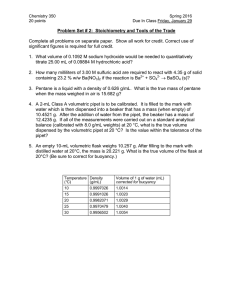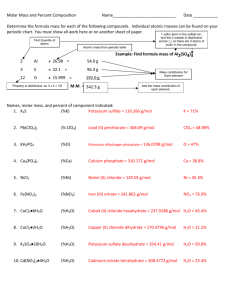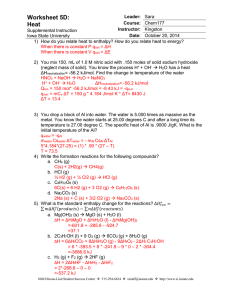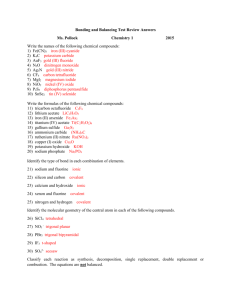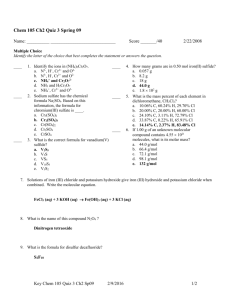Problem Set # 2: Stoichiometry and Tools of the... Complete all problems on separate paper. Show all work... significant figures is required for full credit.
advertisement
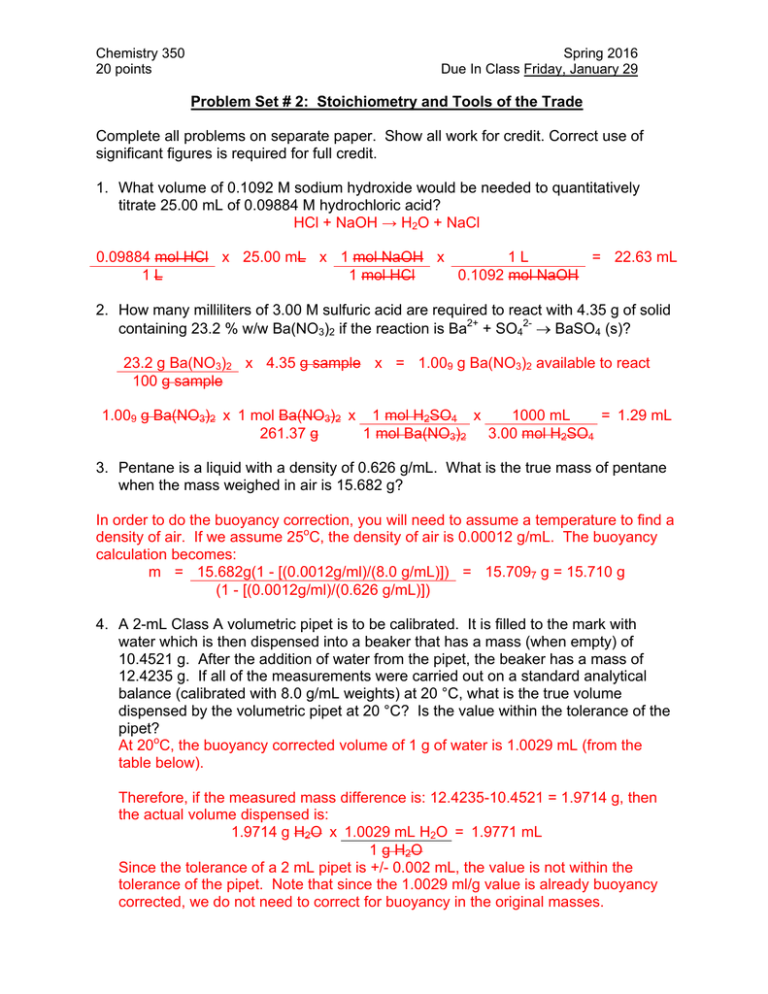
Chemistry 350 20 points Spring 2016 Due In Class Friday, January 29 Problem Set # 2: Stoichiometry and Tools of the Trade Complete all problems on separate paper. Show all work for credit. Correct use of significant figures is required for full credit. 1. What volume of 0.1092 M sodium hydroxide would be needed to quantitatively titrate 25.00 mL of 0.09884 M hydrochloric acid? HCl + NaOH → H2O + NaCl 1L = 22.63 mL 0.09884 mol HCl x 25.00 mL x 1 mol NaOH x 1L 1 mol HCl 0.1092 mol NaOH 2. How many milliliters of 3.00 M sulfuric acid are required to react with 4.35 g of solid containing 23.2 % w/w Ba(NO3)2 if the reaction is Ba2+ + SO42- BaSO4 (s)? 23.2 g Ba(NO3)2 x 4.35 g sample x = 1.009 g Ba(NO3)2 available to react 100 g sample 1000 mL = 1.29 mL 1.009 g Ba(NO3)2 x 1 mol Ba(NO3)2 x 1 mol H2SO4 x 261.37 g 1 mol Ba(NO3)2 3.00 mol H2SO4 3. Pentane is a liquid with a density of 0.626 g/mL. What is the true mass of pentane when the mass weighed in air is 15.682 g? In order to do the buoyancy correction, you will need to assume a temperature to find a density of air. If we assume 25oC, the density of air is 0.00012 g/mL. The buoyancy calculation becomes: m = 15.682g(1 - [(0.0012g/ml)/(8.0 g/mL)]) = 15.7097 g = 15.710 g (1 - [(0.0012g/ml)/(0.626 g/mL)]) 4. A 2-mL Class A volumetric pipet is to be calibrated. It is filled to the mark with water which is then dispensed into a beaker that has a mass (when empty) of 10.4521 g. After the addition of water from the pipet, the beaker has a mass of 12.4235 g. If all of the measurements were carried out on a standard analytical balance (calibrated with 8.0 g/mL weights) at 20 °C, what is the true volume dispensed by the volumetric pipet at 20 °C? Is the value within the tolerance of the pipet? At 20oC, the buoyancy corrected volume of 1 g of water is 1.0029 mL (from the table below). Therefore, if the measured mass difference is: 12.4235-10.4521 = 1.9714 g, then the actual volume dispensed is: 1.9714 g H2O x 1.0029 mL H2O = 1.9771 mL 1 g H2O Since the tolerance of a 2 mL pipet is +/- 0.002 mL, the value is not within the tolerance of the pipet. Note that since the 1.0029 ml/g value is already buoyancy corrected, we do not need to correct for buoyancy in the original masses. Chemistry 260 Chapter 1 – Introduction 2 5. An empty 10-mL volumetric flask weighs 10.257 g. After filling to the mark with distilled water at 20°C, the mass is 20.221 g. What is the true volume of the flask at 20°C? (Be sure to correct for buoyancy.) At 20oC, the buoyancy corrected volume of 1 g of water is 1.0029 mL (from the table below). Therefore, if the measured mass difference is: 20.221g-10.257g = 9.964 g, then the actual volume of the flask is: 9.964 g H2O x 1.0029 mL H2O = 9.993 mL 1 g H2O This value is not corrected for buoyancy, but this one is.
